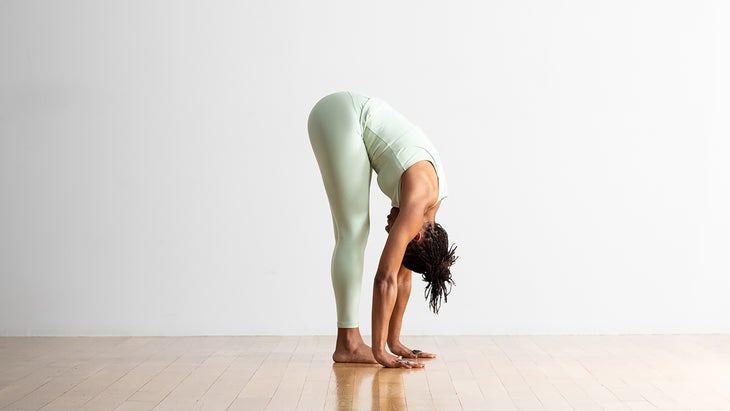“], “filter”: { “nextExceptions”: “img, blockquote, div”, “nextContainsExceptions”: “img, blockquote, a.btn, a.o-button”} }”>
Look around you. Leaves are changing hues. Darkness is quickly overtaking light as the days shorten. Breezes are bracingly cold. Change is inherent in the natural rhythms of the planet. But as needed as change can be, it can also feel unsettling.
According to the ancient science of Ayurveda, many of the traits associated with autumn and change also coincide with vata. This is the dosha, or subtle body energy, that is associated with movement, space, and air. Qualities of this subtle body energy are:
- Cold
- Light
- Dry
- Irregular
- Rough
- Speed
- Changeable
When balanced, the vata in each of us can be incredibly creative and productive. However, with an abundance of vata in the world during fall, it’s easy to fall out of balance. And in excess, vata can result in overactive and anxious thoughts and a pervasive and unshakeable sense of being ungrounded.
There are simple ways to bring your vata back into balance, and one of those is slow, grounding movements. As without, so within.
Tadasana (Mountain Pose)
Try this more grounded version of Tadasana to feel solid and steady as a mountain. Stand with your feet about hip-width apart and parallel. Root your feet firmly to the earth while slightly lifting your inner arches. Lengthen from the root of your pelvis to the crown of your head to rebound the earth energy up into your body. Let your arms extend beside your torso as you cultivate openness across your chest and a slight drawing in of your front ribs. Hold for 5–10 breaths.
Malasana (Garland Pose)

Step your feet out wider than your hips, and turn your toes out by externally rotating your thigh bones in your hip sockets. Descend your hips toward the ground. You can ground your heels on a folded yoga blanket if your heels do not easily touch your mat. Join your palms together in front of your heart center, and lightly press the backs of your arms into your inner knees as you slightly elongate your tailbone. Hold for 5–10 breaths.
Uttanasana (Standing Forward Bend)

From Malasana, return briefly to Tadasana, placing your feet hip-width apart and parallel. You can fold your torso down on top of the front of your thighs, or use a chair to create this pose. If using the chair, hold onto opposite elbows and rest your forearms on the chair’s seat. Allow your head to hang heavy. In all variations of this pose, keep your hips stacked on top of your heels, avoid locking your knees, and firm your belly into your back so that your core muscles support you in the shape. Hold for 5–10 breaths.
Adho Mukha Svanasana (Downward-Facing Dog Pose)

From Uttansana, bend your knees and place your palms on the floor. Walk your feet back until your body forms and inverted “v” shape known as Down Dog. Keep lifting the weight of your torso and hips up and out of your wrists as you reach your heels toward the ground. They may not touch and that’s perfectly fine. If the backs of your legs feel tight, keep a bend in your knees.
Balasana (Child’s Pose)

From Down Dog, slide your knees down to the yoga mat and sink your hips back toward your heels to find Child’s Pose. You can lower your chest to the ground between your thighs, or rest your torso on a bolster. Stay here for 5-10 breaths.
Restorative Supported Twist

Move onto your back with your knees bent and feet grounded. Shift your knees over to your left as you anchor down through both shoulders. You can place your arms in a “T” shape with your palms up. You can release your knees on a yoga blanket or bolster, especially if the floor feels far away. Try lengthening your top hip away from your ribcage. You can turn your head to either side in this twist, or simply gaze up, keeping your neck long and relaxed. Stay here for 5-10 breaths. Repeat on the other side.
Savasana (Corpse Pose)

Try any variation of Savasana, including the one shown, often called Legs Up a Chair. This particular position relaxes your psoas muscle (aka your “fight or flight muscle”), which can help calm your nervous system. Simply rest your lower legs on the seat of the chair, an ottoman, a coffee table, or a low bed. Keep your lower back flat on the floor. You can open your palms to the ceiling or rest your hands on your body. Release your shoulders and let your body feel supported. Breathe here for anywhere from 5-20 minutes.
As you come out, move slowly as you roll onto one side and linger there for several moments. Eventually make your way to a seated or standing position and take your time as you ease back into your day.
RELATED: 10 Things Only Vatas Will Understand
This article has been updated. Originally published October 11, 2020.

